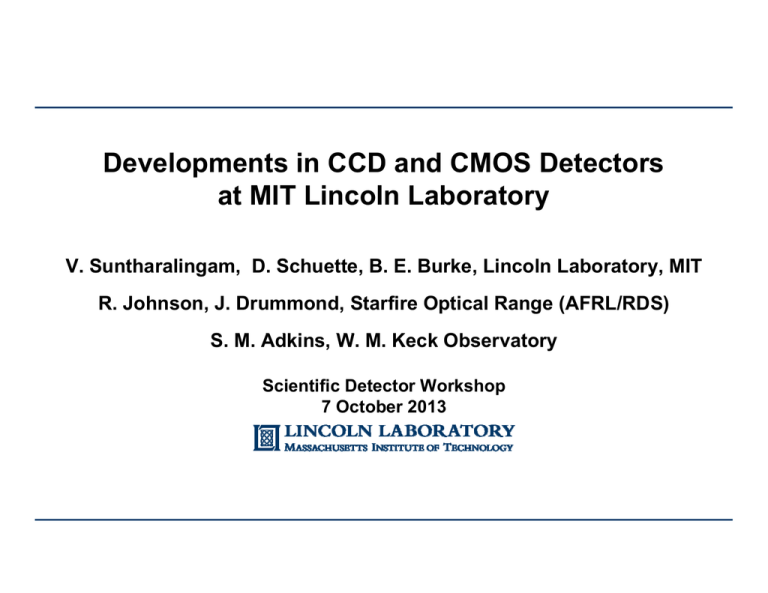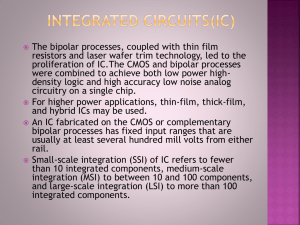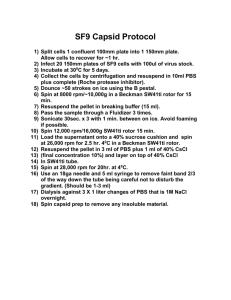Developments in CCD and CMOS Detectors at MIT Lincoln Laboratory
advertisement

Developments in CCD and CMOS Detectors at MIT Lincoln Laboratory V. Suntharalingam, S D. Schuette, S B. E. Burke, Lincoln Laboratory, MIT R. Johnson, J. Drummond, Starfire Optical Range (AFRL/RDS) S M. S. M Adki Adkins, W W. M. M Keck K k Observatory Ob Scientific Detector Workshop 7 October 2013 MIT Lincoln Laboratory • Federally-Funded Research and Development Center (FFRDC) run by the Massachusetts Institute of Technology under contract with the Air Force. Located on Hanscom Air Force Base in Lexington, MA – ~3800 employees – ~$940M/yr (FY12) sponsored research • Primary focus is on the development of prototype radar, communications, and surveillance systems for the DoD and other government agencies – Conduct research in advanced electronics technology gy to support pp and enable new prototype p yp system y development – • Growing segment in industrial-sponsored research through CRDA Work with US industry to transfer Lincoln Laboratory technology to meet future DoD and government needs MITLL SDW 2013- 2 VS 10/07/13 Unique Focal-Plane Technology in Support of National Security AMOS (AF) DoD Satellites Directed Energy AFRL SOR Space Surveillance Laser Radar MITLL SDW 2013- 3 VS 10/07/13 Astronomy National Ignition Facility (LLNL) Nuclear Stockpile Stewardship (LANL) Microelectronics Laboratory • • Specially designed 70,000 square foot building – – First completed silicon (Spring 1993) Converted to 150 mm wafer p processing g in 1996 – Converted to 200 mm wafer processing (Spring 2011) Clean Room space – – • 8,100 8 100 Square feet of class-10 class 10 10,000 Square feet of class-100 Microelectronics Laboratory activities – – – > 30 Active programs in support of 4 divisions > 65 People from 5 groups working full-time in facility (Scientists, Engineers, and Technicians) Two-shift operation, p , 6 am to 11 pm, p , 5 days/week y Facility/Equipment Value ~$175-200M $ MITLL SDW 2013- 4 VS 10/07/13 Spanning Research to Low-Volume Prototyping in One Facility 22M-pixel Orthogonal Transfer Array Focal Plane Tiles MEMS RF Switches S it h Graphene Devices 6 m pixel pitch 3D via MASIVS Focal Plane Array SOI/CMOS pixel circuitry bond line 150-mm InP wafer 9-nm Gate-Length Fully Depleted SOI Device Research/ Novel Materials MITLL SDW 2013- 5 VS 10/07/13 InGaAs InP/CMOS 3-D Integration of SWIR FPA Demonstration Circuits/Devices Curved CCD Focal Plane Arrays for Space Surveillance Telescope Low volume, specialized, sophisticated prototypes Growth in Wafer and Device Sizes Wafer area Largest Lincoln Imagers Digital SLR sensors Microelectronics Lab opened MITLL SDW 2013- 6 VS 10/07/13 Compact cameras Cell-phone cameras Existing Sensors for Adaptive Optics Sensors for Adaptive Optics Device Format ((Ports)) Pixel Size Frame Rate Read Noise Comment CCID26 128 × 128 (16) 21 µm 2.5 kfps 7 e– Electronic shutter CCID66 CCID66 160 × 160 ((20)) 21 µm 21 µm 2.5 kfps 2.5 kfps 4 e 4 e– High‐responsivity pJFET charge‐sense with two‐stage on‐chip amplification ih hi lifi i Die Photo MITLL CCID26 MITLL SDW 2013- 7 VS 10/07/13 Die Photo MITLL CCID66 7 Photomicrograph Detail of Wafer MITLL SDW 2013- 8 VS 10/07/13 8 Evolutionary Technology Enhance NIR Sensitive AO CCD Sensors for Adaptive Optics • MIT-LL CCID75: Adaptive Optics CCD with readout port isolation and region-of-interest for high-frame-rate / low-latency operation Design Parameter CCID75 Photograph Goal Array Size 160 × 160 Pixel Pitch 21 µm Well Depth > 50,000 e– Wavelength 0.4 – 1.1 µm Frame Rate 2.5 kfps CCID75 MITLL SDW 2013- 9 DISTRIBUTION C. Distribution authorized to U.S. Government Agencies and their contractors; Specific Authority (AFRL/RD Critical Information List); VS 10/07/13 20130920. Other requests shall be referred to AFRL/RDSA, 3550 Aberdeen Avenue SE, Kirtland AFB, NM 87117‐5776. Targeted Technology Polar Coordinate Imager Sensors for Adaptive Optics • Example: Polar coordinate imaging to address the challenge of Adaptive Optics for extremely-large telescopes Sodium beacon images • Sodium beacon image elongates radially as the distance from center of the focal plane increase • Many small CCD arrays located and oriented to optimally sample each sub‐aperature MITLL SDW 2013- 10 VS 10/07/13 1 0 Front illumination test results Courtesy S. M. Adkins Device L1-W1-C3 L1-W3-C1 Units Read noise 3 47 3.47 3 24 3.24 eFull well 26844 24967 eNon-linearity 1.2 1.4 % Responsivity 15 16 μV/eCTE Dark current ~10* ~2.1 e-/pixel/s S i l CTE Serial 0 999991 0.999993 0.999991 0 999993 Parallel CTE CTI 0.999990 0.999990 Charge diffusion 0.25 0.37 pixels * = device operated at -8 °C • L1-W1-C3 was not baked and has an epoxy seal • Later determined devices were operating at ~ -15 C and ~ -29 C MITLL SDW 2013- 11 VS 10/07/13 11 Read noise, gain, full well Device Video channel Read noise Gain (e-/DN) Full well Video channel Read noise Gain (e-/DN) Full well Device Video channel Read noise Gain (e-/DN) Full well Video channel Read noise Gain (e-/DN) Full well MITLL SDW 2013- 12 VS 10/07/13 Courtesy S. M. Adkins L1-W1-C3 Average 1 2 3 4 5 6 7 8 9 10 11 12 13 14 15 16 3.46 3. 6 3.7 3.71 3.73 3. 3.23 3 2.96 .96 3.6 3.61 3. 3.26 6 3. 3.28 8 3.7 3.71 3.70 3.5 3.54 3.69 3. 3.45 5 3.5 3.54 3. 3.28 8 3.3 3.32 3.35 0.53 0.56 0.56 0.50 0.48 0.52 0.52 0.55 0.53 0.55 0.54 0.56 0.54 0.53 0.49 0.53 0.56 26714 26806 25122 25305 27528 25095 24579 28898 26129 29114 27378 26000 27847 26691 26558 26989 27377 Average 17 18 19 20 21 22 23 24 25 26 27 28 29 30 31 32 3.48 3.15 3.60 3.10 3.74 3.63 3.12 3.63 3.79 3.74 3.70 3.74 3.42 3.11 3.19 3.75 3.28 0.54 0.50 0.55 0.53 0.52 0.53 0.54 0.55 0.54 0.54 0.50 0.53 0.55 0.55 0.56 0.54 0.56 26974 26945 27507 28402 24927 27365 28108 27896 28758 27847 26008 25474 26388 27306 24502 28523 25624 L1-W3-C1 Average 1 2 3 4 5 6 7 8 9 10 11 12 13 14 15 16 3.18 3.20 2.83 3.63 3.28 3.54 3.24 3.68 2.84 3.01 2.89 3.15 3.66 2.77 3.04 3.25 2.77 0.52 0.46 0.50 0.51 0.50 0.51 0.49 0.49 0.45 0.54 0.52 0.56 0.57 0.54 0.57 0.54 0.55 25452 24590 26281 26004 23839 24258 26982 24813 24676 23702 26312 24779 26802 25365 27091 24873 26864 Average 17 18 19 20 21 22 23 24 25 26 27 28 29 30 31 32 3.30 3.57 3.65 2.86 3.75 2.95 2.86 3.49 3.04 3.13 3.71 2.87 3.50 2.95 3.66 3.19 3.64 0.52 0.53 0.50 0.57 0.47 0.53 0.50 0.54 0.45 0.55 0.53 0.56 0.56 0.52 0.51 0.50 0.50 24482 23327 25106 22943 23667 23141 24771 23276 26526 25514 26141 25086 25412 24347 25053 23157 24247 12 Transition from 150-mm to 200-mm Wafers CCID-20 150 mm CCID-78 200 mm SVG i-line Scanner Canon i-line Stepper (0.25 NA) 1× scanner (150-mm field) < 100-nm overlay ~500 nm overlay typ. 800-nm resolution 2 µm resolution typ 2-µm typ. 2× stepper t (> 50 × 50 mm fi field) ld) MITLL SDW 2013- 13 VS 10/07/13 I-line Stepper Lithography 200-mm Wafer Capability Demonstrators Same Reticle Used Full Field Stepping Full Field Stepping 16 CCDs Per Wafer 150 mm 200 mm FI = Front Illuminated MITLL SDW 2013- 14 VS 10/07/13 200 mm Results from First 200-mm CCD Lot 3k x 3k Image Array and Frame Store (9.5µm pixel) Kalpha Kbeta FI w2-R3C2 MITLL SDW 2013- 15 VS 10/07/13 Uniformity of Large Area CCDs BI 1k x 2k FI 3k x 3k Output Circuits 60 sec integration at -20°C MITLL SDW 2013- 16 VS 10/07/13 5.1 cm 5 5.4 cm 5 +/- 1% BICCID-78 L1a-W1-C7 Imaging Array at -30°C using 430 nm LED 20-port Adaptive Optics Device CCID75 Orthogonal Transfer Arrays for Pan-STARRS GPC2 • Device Improvements (CCID71) – Improved video quality by using only 2-phase devices – Increased full well – Improved fill factor – Reduced persistence and amplifier glow – Better AR coating 150 mm wafer Packaged BI Device Fe55 X-ray events in OTA cell • Partially populated GPC2 with BI OTAs from 150-mm lots • 200-mm wafer OTA i process in development – Fe55 X-rays detected with first FI devices 200 mm wafer MITLL SDW 2013- 17 VS 10/07/13 FI OTA image Stitched Large Format Arrays • Stitching is used when imager size exceeds lithography exposure field – DUV Stitching methods achieved 35-nm (3) precision • Mix-and-Match is used to combine fine-line (90 nm) Front End of Line lithography with thick, wide routing metals in Back End of Line steps – In use for 3-D integrated g imagers g Multi-field Reticle Reassembled Design on Wafer 50 0mm Functional Blocks 150 mm MITLL SDW 2013- 18 VS 10/07/13 New Process Technology for OTCCDs Current process • Four polysilicon layers • Clock voltages: 8 – 10 V • Pixel sizes > 9 µm 10-µm pixels (four poly layers) Advanced process • Single or Two polysilicon layers • Clock voltages: down to 2 V • Pixel sizes > 5 µm ➡ Simplified fabrication but requires sub-µm lithography µ p 8-µm pixels (two poly layers) MITLL SDW 2013- 19 VS 10/07/13 Collection of Fe55 X-ray Events in IA 3k x 3k, 8-µm pixel OTCCD Fe55 events captured throughout Imaging array 50mm Functional Blocks MITLL SDW 2013- 20 VS 10/07/13 Completed Back-Illuminated Devices Chip Photomicrograph Details MITLL SDW 2013- 21 VS 10/07/13 QE of Back-Illuminated Devices Effect of Detector Thickness (75 µm thick, Broadband ARC)) (45 µm thick, Red-optimized ARC) MITLL SDW 2013- 22 VS 10/07/13 Minimizing Dead Layers Through MBE • MBE enables the growth of ultra-thin (5-10 nm) Si:B passivation layers for BI-CCDs – Very low dark current – High spatial uniformity – Quantum-limited UV detection efficiency 200-mm wafer MBE p process successfully y demonstrated In situ e- diffraction images show epitaxial film growth Si wafer before MBE Epitaxial Si:B film Veeco Gen200 – The ML’s 200 mm MBE System Si:B Doping Profile – 200 mm Wafer B Doping (atom ms/cc) 1E+22 Si:B Film 1E+21 1E+20 Gen200 Capability Exceeds Need! 1E+19 1E+18 Target Doping Level 1-2 x 1020 cc-1 1E+17 Substrate 1E+16 1E+15 0 20 40 60 Depth (nm) MITLL SDW 2013- 23 VS 10/07/13 80 100 120 Completed MBE-Treated Devices 430nm LED Resolution Target Fe55 Single Pixel events at -50C Inefficienc < 10-66 Charge Transfer Inefficiency< MITLL SDW 2013- 24 VS 10/07/13 Advantages of 3-D IC for Advanced Focal Planes Addressing A Conventional Monolithic CMOS Image Sensor PD 3-D Pixel Light pixel 3T Photo Detector pixel Readout Processor Addressing A/D, CDS, … • Pixel electronics and detectors share area • Control and support electronics placed outside of imaging area • Fill factor loss • Co-optimized fabrication MITLL SDW 2013- 25 VS 10/07/13 • 100% fill factor detector • Fabrication optimized by layer f function ti • Local image processing large-area • Scalable to large area focal planes 3-D Imager Demonstrations at MIT-LL CMOS Image Sensor Four-side Abuttable CMOS APS (IEEE ISSCC 2005) (IEEE ISSCC 2009) 2 Tiers 7 Tiers CMOS Imagers for Daylight Applications 8 mm GmAPD Laser Radar (IEEE ISSCC 2006) Mixed Material/Process Imagers 3D 3-D Via InGaAs Detector (IEEE 3DIC 2009) SOI readout 10 m ~70m Ti 3 1 Tier-3: 1.5V 5V SOI CMOS L Layer Tier-2: 3.5V SOI CMOS Layer 3-D Tier-2: 3.5V SOI CMOS Layer via 8 m Tier-1: InGaAs PIN diode (epi) Tier-1: 30V Back Illuminated APD Layer MITLL SDW 2013- 26 VS 10/07/13 InP substrate 10 m 3-Tier 3DIC Cross-Section Transistor Layers 3D Via Tier -3 Tier -2 Tier -1 RF Back Metal Oxide Bond Interface 3D Via Oxide Bond Interface Tier-1 Transistor Layer 20 m Three FDSOI CMOS Tiers, total active circuit height ~ 21 um Tier 1 bottom, Tier 2 and Tier 3 inverted and bonded on top, substrates removed 11 metal interconnect layers thick RF top metal Dense unrestricted 3D vias for electrical connections between tiers MITLL SDW 2013- 27 VS 10/07/13 Summary • Lincoln Laboratory is now fabricating scientific detectors on 200-mm silicon substrates – Stitching to produce very large format devices – Uniform response and broad-band sensitivity – Advancements in Back Illumination technology • Ongoing work to design and fabricate new designs for adaptive optics applications • Increased on-focal plane processing anticipated with next generation 3-D integrated circuit technologies MITLL SDW 2013- 28 VS 10/07/13 Acknowledgements • The Lincoln Laboratory, Massachusetts Institute of Technology – Brian Aull, Barry Burke, Michael Cooper, Brad Felton, Jim Gregory, Renee Lambert,, Dan O’Mara,, Robert Reich,, Dan Schuette,, Doug g Young, g, and members of the Advanced Imagers and Silicon Technology Group • Starfire Optical Range Range, Air Force Research Laboratory – Robert Johnson, John Wynia • AODP Project Collaborators – Sean Adkins, James W. Beletic, Barry Burke, Charlie Bleau, Jerry Nelson, Ray DuVarney, Richard Stover and Francois Rigaut • Pan-STARRS Project j Collaborators – John Tonry, Will Burgett, Peter Onaka • The TMT Project Office – Corrine Boyer, Boyer Brent Ellerbroek MITLL SDW 2013- 29 VS 10/07/13






